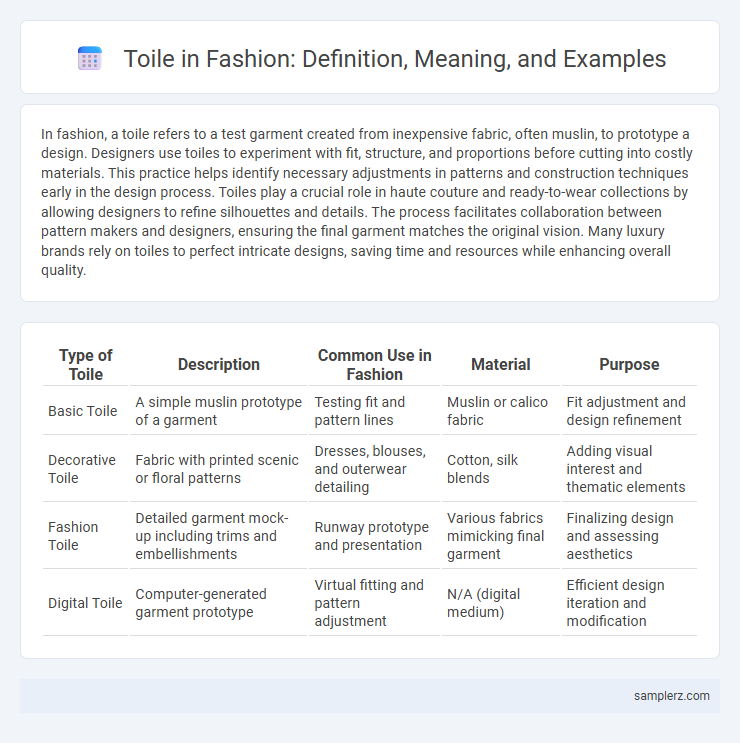In fashion, a toile refers to a test garment created from inexpensive fabric, often muslin, to prototype a design. Designers use toiles to experiment with fit, structure, and proportions before cutting into costly materials. This practice helps identify necessary adjustments in patterns and construction techniques early in the design process. Toiles play a crucial role in haute couture and ready-to-wear collections by allowing designers to refine silhouettes and details. The process facilitates collaboration between pattern makers and designers, ensuring the final garment matches the original vision. Many luxury brands rely on toiles to perfect intricate designs, saving time and resources while enhancing overall quality.
Table of Comparison
| Type of Toile | Description | Common Use in Fashion | Material | Purpose |
|---|---|---|---|---|
| Basic Toile | A simple muslin prototype of a garment | Testing fit and pattern lines | Muslin or calico fabric | Fit adjustment and design refinement |
| Decorative Toile | Fabric with printed scenic or floral patterns | Dresses, blouses, and outerwear detailing | Cotton, silk blends | Adding visual interest and thematic elements |
| Fashion Toile | Detailed garment mock-up including trims and embellishments | Runway prototype and presentation | Various fabrics mimicking final garment | Finalizing design and assessing aesthetics |
| Digital Toile | Computer-generated garment prototype | Virtual fitting and pattern adjustment | N/A (digital medium) | Efficient design iteration and modification |
Understanding Toile: Definition and Significance in Fashion
Toile in fashion refers to a prototype garment made from inexpensive fabric, typically muslin, used to test fit and design before final production. It allows designers to visualize and adjust the garment's structure and proportions, ensuring precision in tailoring and silhouette refinement. This practice is crucial for translating creative concepts into wearable fashion pieces, minimizing costly errors during manufacturing.
Historical Evolution of Toile in Fashion Design
Toile, originally a simple cotton or linen fabric used for garment mock-ups, has played a pivotal role in fashion design since the 16th century. During the Victorian era, its application evolved beyond prototypes, influencing intricate toile de Jouy prints that symbolized luxury and artistic storytelling. By the 20th century, designers like Christian Dior incorporated toile both as a foundational tool and as a decorative element, highlighting its enduring significance in the historical evolution of fashion.
Famous Fashion Houses Utilizing Toile Techniques
Famous fashion houses such as Christian Dior and Chanel have famously utilized toile techniques to create intricate, muslin mock-ups that perfect garment structure before final production. Dior's use of toile allowed precise tailoring and elegant silhouettes, showcasing craftsmanship at haute couture levels. Chanel similarly employs toile to refine fit and drape, ensuring timeless sophistication in its iconic designs.
Step-by-Step Process: Creating a Toile in Fashion
Creating a toile in fashion begins with drafting a basic pattern on inexpensive muslin fabric to test garment fit and design. The tailor or designer assembles the toile using simple stitching, allowing easy adjustments before cutting the final fabric. Fitting sessions with the toile enable precise modifications that refine the garment's silhouette and structure prior to final construction.
Key Materials Used for Making Toile Garments
Toile garments are typically crafted from plain, unbleached cotton or muslin, chosen for their affordability and ease of manipulation during the design process. These fabrics provide a lightweight, breathable canvas that allows designers to test garment fit and structure before final production. The choice of natural fibers ensures accurate draping and pinning, critical for pattern adjustments in haute couture and ready-to-wear collections.
Textile Types Commonly Selected for Toile Prototypes
Cotton muslin remains the most popular textile for toile prototypes due to its affordability, lightweight nature, and ease of handling during fittings. Linen also serves as a common choice, offering durability and a natural texture that mimics the final garment fabric. Designers occasionally select lightweight canvas or broadcloth to achieve more structure in toile samples, enabling precise visualization of garment shapes and seams.
Benefits of Using Toile in Garment Construction
Toile in fashion serves as a vital prototype, allowing designers to test fit, proportion, and design details before final production, reducing costly errors. Using toile enhances garment construction by providing a three-dimensional reference that ensures precise adjustments and fabric behavior assessment. This practice ultimately streamlines the development process, improving the overall quality and fit of the final garment.
Notable Examples of Toile in Haute Couture Collections
Notable examples of toile in haute couture collections include Dior's meticulous toile fittings, which allow designers to perfect the intricate structure and fit of their garments before finalizing luxurious fabrics. Chanel frequently employs toile prototypes to refine the silhouette and drape of its iconic tweed suits, ensuring precision in craftsmanship. Valentino's haute couture ateliers rely on toile iterations to sculpt fluid shapes and elaborate embroidery placement, reflecting the meticulous attention to detail characteristic of elite fashion houses.
Toile vs Muslin: Comparing Prototyping Methods in Fashion
Toile and muslin serve as essential prototyping fabrics in fashion design, with toile typically consisting of a sturdier cotton or linen canvas used for precise garment fitting and structural testing. Muslin, a lightweight cotton fabric, is preferred for initial draping and quick mock-ups due to its affordability and ease of manipulation. Comparing prototyping methods, toiles provide accurate garment construction insights, while muslins offer speed and flexibility during early design stages.
Modern Innovations and Trends in Toile Application
Modern innovations in toile application include 3D printing techniques that create intricate, customizable toile patterns on fabrics, enhancing precision and design complexity. Sustainable textile technologies now incorporate eco-friendly toile prints using plant-based inks and recycled materials, aligning with the growing demand for environmentally conscious fashion. Digital textile printing enables rapid prototyping and on-demand production of toile designs, revolutionizing traditional sample-making processes in fashion design.

example of toile in fashion Infographic
 samplerz.com
samplerz.com